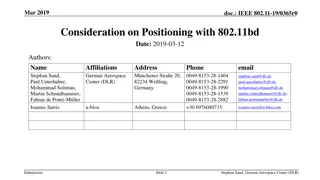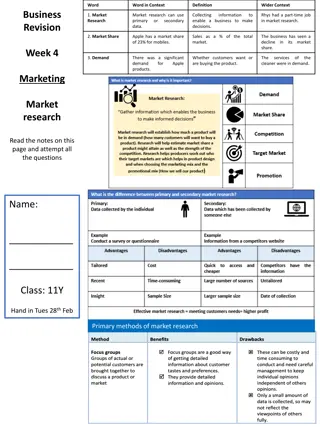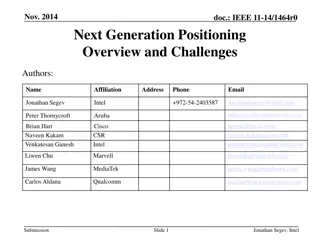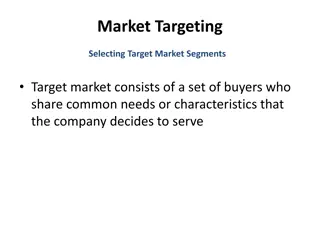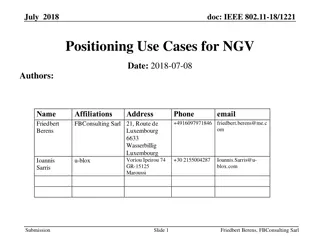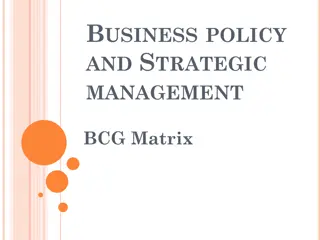Understanding Market Positioning: Importance, Types, and Strategies
Market positioning is crucial for creating a distinctive image of a product or service in the minds of consumers. This involves different types of positioning such as functional, symbolic, and experiential, each serving a unique purpose. Creating an effective market positioning strategy requires identifying uniqueness, analyzing competitor positioning, and developing a clear strategy to set your brand apart. By focusing on product features, utility, benefits, and strategic positioning, businesses can successfully position themselves in the market.
Download Presentation

Please find below an Image/Link to download the presentation.
The content on the website is provided AS IS for your information and personal use only. It may not be sold, licensed, or shared on other websites without obtaining consent from the author. Download presentation by click this link. If you encounter any issues during the download, it is possible that the publisher has removed the file from their server.
E N D
Presentation Transcript
Positioning ,Importance,Types,Competitive Advantage
What is Positioning? Positioning is the process of creating a distinct mental position or image of a product or a service in the mind of the customers as compared to other brands in the market. Positioning helps to create a unique image of the brand and the product in the mind of the consumers in comparison with other products or brands which are already existing in the market. Every marketer considers the brand positioning as one of the most important aspect of overall brand creation. People have different perception about a brand based on how the brand was positioned in the market.
How to Create an Effective Market Positioning Strategy? Create a positioning statement that will serve to identify your business and how you want the brand to be perceived by consumers. For example, the positioning statement of Volvo: For upscale American families, Volvo is the family automobile that offers maximum safety. 1. Determine company uniqueness by comparing to competitors Compare and contrast differences between your company and competitors to identify opportunities. Focus on your strengths and how they can exploit these opportunities. 2. Identify current market position Identify your existing market position and how the new positioning will be beneficial in setting you apart from competitors. 3. Competitor positioning analysis Identify the conditions of the marketplace and the amount of influence each competitor can have on each other. 4. Develop a positioning strategy Through the preceding steps, you should achieve an understanding of what your company is, how your company is different from competitors, the conditions of the marketplace, opportunities in the marketplace, and how your company can position itself.
Positioning is broadly classified into three types: 1. Functional This is used when the brand or products provide solutions to problems and provide benefits to customers. It focuses on the function, benefit or utility that it gives to the customer. 2. Symbolic This is useful for creating a brand image which helps create brand equity, a sense of social belongingness and ego-identification. It is when a customer has an affection, social connection, ego identification etc. with the product. 3. Experiential This creates sensory and cognitive simulation in the minds of the customer. It is one of the basis of the experiences which a customer can relate to. Companies use a positioning process, which is step-wise method to place the product or service in the right way in the consumer's mind. If a company decides to change the way people perceive a brand, then they revamp the logo, slogan etc. of that brand. This process is known as repositioning of the brand, which helps create a different image of the brand.
The main factors considered by a marketer for creating a strategy for a brand or product are: 1. Product Features Positioning can be done on how the product looks, feels, appears etc. The main features of the products can be used to highlight the value and create the positioning around it. 2. Utility & Benefits It takes into account the value which a product gives and which needs are solved. It should show the clear benefit in terms of dollar value or number E.g. 50% savings in electricity expenses can be a clear benefit to a customer. 3. Use Categories This defines how the product can be used. All the different use cases and scenarios can be used to create a compelling positioning. 4. Occasion The time, event or the occasion when the product can be used. Association with an event like New Year can lead to strong positioning in the minds of customer.
5. Competitive Comparison Positioning can be done when compared to a competitive offering. This is done by a lot of companies to use existing competitive positioning and make it better using points of parity or points of differentiation to create a better positioning. In positioning the product is differentiated based on 2 things to achieve competitive advantage: - Points of Parity (POPs) The positioning is done on the basis of mostly similar elements compared to a competitor. Points of Difference (PODs) In this case, there is a clear difference in the product offerings vis- -vis the competitor.
The above product positioning graph for laptop, i-pod, netbook and kindle shows the benefits in terms of different parameters. This method of understanding positioning is also known as perceptual mapping or brand mapping.
Examples of Positioning Positioning examples of products can be understood on the basis of various parameters, characteristics and features of products & services. Some key examples are: 1. Aspirational: Nike (Just Do It). 2. Emotional: Coca Cola (Open Happiness). 3. Price-Based: Rolls Royce (Trusted to Deliver Excellence). 4. Problem Solution: Head & Shoulders shampoo (Dandruff free hair). 5. Benefits: Colgate (Prevents cavity and fresh breath).
Competitive Advantage from positioning: 1.Be first in the market Buyers tend to stay with what they know. By being first to market, you will be able to take advantage of having no competition with your offering (also known as the first-mover advantage). However, it can take time to gain market acceptance of new ideas, and being first does not last forever. 2.Leverage your expertise: Establish leadership Being perceived as an expert in your market bestows on you a level of trust, which transfers to your products. You can establish leadership in different areas, such as technology, science or sales. Develop your reputation and expertise with knowledge-sharing activities, such as writing blogs, articles or white papers, or presenting webinars. Focus your market expertise .
Establish your expertise by focusing on one particular niche to develop market specialization. Your market-specific expertise will set you apart from the competition. For example, instead of concentrating on a wide market encompassing all doctors, zero in on a niche within that market, such as pediatricians. This would enable you to specialize in, and appeal to, a pediatrician s particular needs. Otherwise, your offering may not hold enough appeal to the wider audience to give you an advantage over your competition. 3.Make your products stand out as new and improved Study your competitors and learn how they target a market problem. Ensure that the problem is an important one, and that your solution is better. Then reposition this market problem with your own unique solution. You can capitalize on your competitors marketing, but make sure to position your product as the" next generation. For example, when microwave ovens were flooding the market, new entrants adjusted their positioning by marketing their products as speed cookers that evenly cooked food, a significant improvement over their microwave counterparts.
Competitive Advantage from postioning: Quality and customer orientation Although it is important to manufacture good quality products and be customer-oriented, these factors will not set you apart from the competition. Since your product is on the market, the tacit understanding is that the quality is good. Customer service It is assumed that you will work diligently to ensure customer satisfaction. This alone will not keep those customers coming back to you. According to Jack Trout, in Differentiate or Die, it was found that 40% of satisfied customers would change brands without looking back. Price Although pricing your products below market price might attract some buyers, it will not differentiate your product for long. Being cheaper than an alternative will not position you as unique. It will place you in a weak position because your competition could change their price to match yours at any time. Breadth of line Based on the success of superstores, you might be tempted to become everything to everyone. However, this is not differentiation. You might solve some problems for some customers, but it is more likely that you will not fully solve any customers problems. Provide a specific solution to ensure that you solve real problems for a specific target market.






